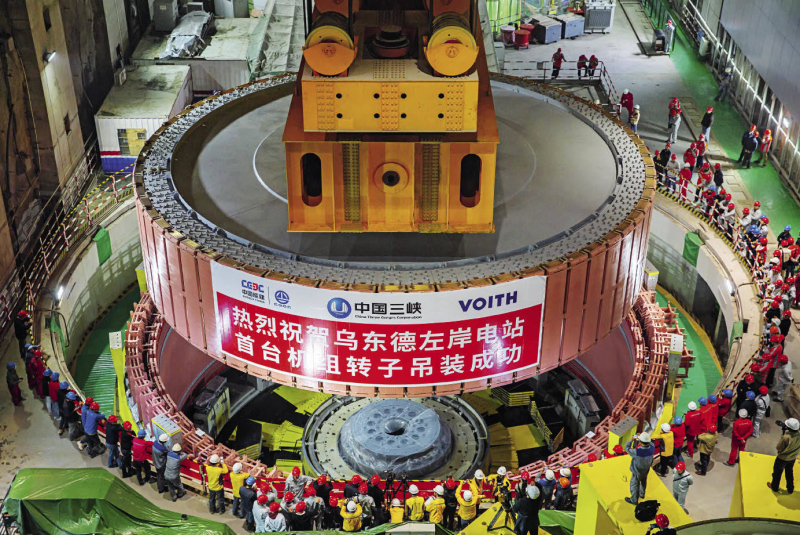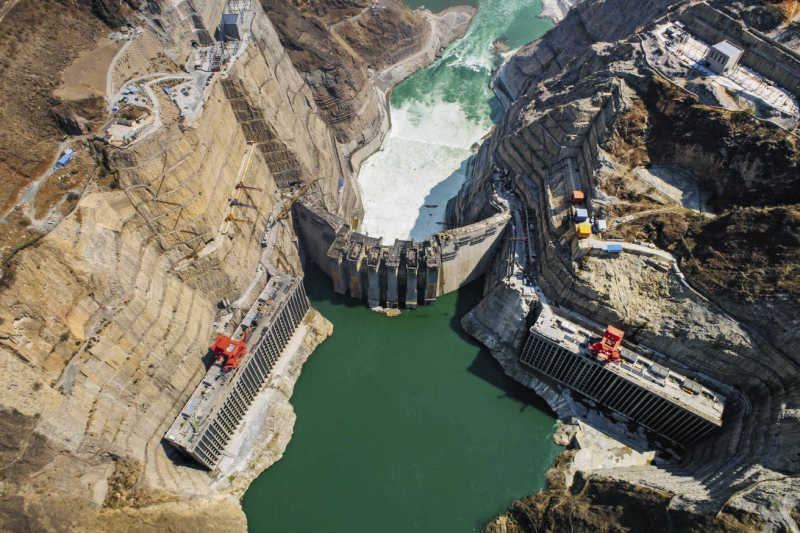
A ceremony is held to celebrate the first electricity-generation units on the left bank of the Wudongde Hydropower Station.
Spanning the Jinsha River, the Wudongde Hydropower Station is located on the border of southwest Sichuan and Yunnan provinces. The Jinsha River, 3,500 kilometers long, constitutes the upper stretches of the Yangtze River, the largest river in China. It is the largest hydropower base in China, with an output potential of up to 120 million kW, leading the world in hydropower resources.
An important task of the station’s construction was to relocate residents of the area. During this process they were introduced to a much higher quality of life. One of these residents, Tian Taixue, said the relocation has changed his life significantly.
“We used to live in adobe houses in a valley in Liangshan Prefecture, but now we live in multi-story apartment buildings. There were only bumpy dirt roads in my former community, now cement ones lead to each home. In the past, in order to buy a bag of fertilizer, the logistics cost more than the fertilizer itself, while now it can be delivered to your door with just a phone call. Life is much easier today,” said Tian.
Relocation Journey
Tian’s home relocation for the Wudongde hydropower project took place in August 2019, when his family of three were moved from Huidong County in Liangshan Prefecture, Sichuan Province to the Jinrui Community of Wudongde Township, Luquan County in Yunnan. As one of the communities for resettlement, Jinrui mainly received people from Huidong and Huili counties in Liangshan Prefecture. By the end of 2019, around 3,700 people from 1,000 households had resettled here.
The construction of Wudongde Hydropower Station began in December 2015 by China Three Gorges Corporation, with a total installed capacity of 10.2 million kW and an average annual power generating capacity of 38.91 billion kWh. All electricity-generation units are expected to come into operation by July 2021.
“By the end of 2019, we had completed the relocation and resettlement of people for the Wudongde Hydropower Station area. A total of 32,000 migrants from 10 counties (districts) in Yunnan and Sichuan were moved into 24 resettlement sites,” Yao Yuanjun, director of the migration affairs office of China Three Gorges Corporation, told China Today. The new residents now have access to convenient transportation, quality education, and medical services. “All the 3,200 documented poor migrants have been lifted out of poverty as a result of the resettlement,” said Yao.
According to Yao, the project’s aim has always been to benefit the people and provide clean hydropower energy — a combination of scientific elements and people’s welfare.
During the construction of the Wudongde Hydropower Station, about 70,000 jobs have been created every year. When the electricity-generation units are fully operational, they will contribute about RMB 11.9 billion of industrial added value every year.
Jiao Lin, CPC secretary of Luquan County, said the county would exploit the opportunities brought about by the Wudongde Hydropower Station to develop cultural tourism, modern logistics, financial services, and other industries.
Balancing Ecological
Protection and Economic Development
“The Wudongde Hydropower Station is currently the fourth largest station of its kind in China and the seventh largest in the world. It is the first world-class 10 million kW hydropower station that China is constructing and putting into operation since the 18th National Congress of the CPC,” said Yang Zongli, director of the Wudongde project. He told China Today that the clean hydropower output from the station will be sent to the Southern Power Grid to facilitate development of the Greater Bay Area in Guangdong, Hong Kong, Macao and other areas. The hydropower station will become the backbone of China’s energy strategy of “west-east power transmission.”
Wang Hao, an academician of the Chinese Academy of Engineering, said as the first group of electricity-generation units at the Wudongde Hydropower Station are put into use, a world-class clean energy corridor comes into being. The construction of this hydropower station is not only a vivid demonstration of Xi Jinping’s thought on ecological civilization, but also an example of China’s efforts to promote high-quality development through green development.

An aerial view of Wudongde Hydropower Station.
According to Wang, there is a broad consensus and common direction of action in the international community to develop clean and renewable energy and to promote the transformation of energy structure. “The clean hydropower produced by this station will become an important support for the transmission of power from the west [of the country] to the east. Under the current energy structure dominated by fossil energy, the proportion of hydropower in the energy mix can be further increased to optimize the national energy structure and ensure energy security.”
Wang said the completion of the Wudongde Hydropower Station has laid an important foundation for the construction of a world-class clean energy corridor in southwest China.
It is estimated that the green power generated by the Wudongde Hydropower Station will save 12.2 million tons of standard coal each year, and reduce emissions of carbon dioxide and sulfur dioxide by 30.5 million tons and 104,000 tons respectively, equivalent to planting 85,000 hectares of hardwood forest. It will help China achieve its energy conservation and emission reduction targets.
The power station will inevitably affect the living environment of migratory fish. However, every coin has two sides. Due to the completion of the dam the river slows down and becomes deeper, which will promote the mass reproduction of still-water fish.
To reduce the impact on migratory fish, the project has spent hundreds of millions of extra dollars to optimize the dam’s design, ensuring the normal environment of fish by a variety of technical means.
“We recycle waste water to irrigate slopes of more than one million square meters, and as a result, vegetation covers the former barren land. Besides, we have also bred and released rare and unique fish in the lower reaches of the Jinsha River,” Yang Zongli told China Today.
Yang said that the concept of “prioritizing ecological and green development” was applied throughout the whole construction of the hydropower station. Through various efforts, including water and soil conservation and ecological restoration, the project strives to keep a balance between ecological protection and hydropower development.
Technological Innovation
At 3:30 p.m. on May 4, 2020, the concrete pouring of the main part of the dam of the Wudongde Hydropower Station, the world’s thinnest 300-meter super-high arch dam, was finished.
The Wudongde dam has two arches, divided into 15 sections for pouring. The total amount of concrete poured was about 2.7 million cubic meters. The dam crest is 988 meters above sea level, the maximum dam height is 270 meters, and the upstream arc length of the dam crest is 326.95 meters. Its thickness to height ratio is only 0.19. It is the world’s first extra high arch dam where low-heat cement concrete was used in the full dam wall.
“The difficulty lies in controlling the temperature while pouring large volumes of concrete. Too high a temperature can crack concrete,” Yang said, “Even the smallest cracks can have a disasterous effect on the dam.”
The Jinsha River has a dry and hot valley climate where the temperature can reach more than 40 degrees Celsius. “We did something unprecedented in the history of dam construction in the world — the use of low-heat cement concrete for the whole dam,” said Yang, adding that the dam wall is seamless, unlike any other dams.
Thermometers and cooling pipes were embedded in the concrete, and the water flow was automatically adjusted through the intelligent water supply system to realize intelligent cooling of concrete. More than 8.06 million pieces of data were monitored for the concrete’s internal temperature, and 4.39 million pieces of data for cooling and water supply were gathered, said Yang. The Wudongde dam is regarded as one of the “smartest” dams in the world.
During construction, builders also overcame some worldwide technical problems, creating a number of world and industry firsts.